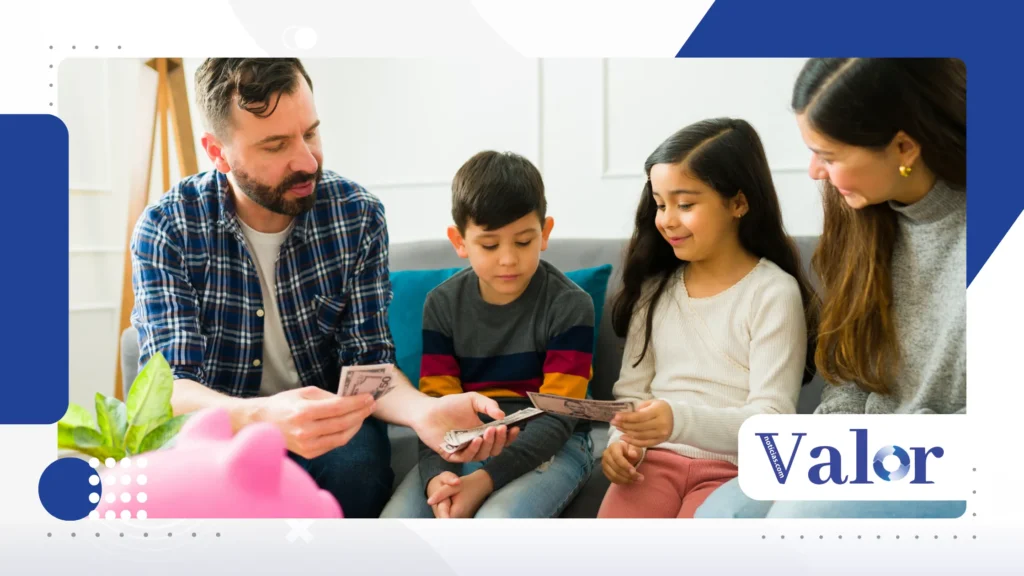Can you talk about economics with children? Yes, and here's how.

First of all, yes: it is possible and necessary. talking about economics with childrenThis topic, long seen as an “adult matter,” is now recognized by educators and experts as essential for emotional and social development.
Advertisements
Teaching from an early age how money circulates, what responsible consumption is, and how to plan goals not only forms future investors—but also conscious citizens capable of making balanced decisions in an increasingly financially unstable world.
More than numbers and calculations, economics is about choices, priorities, and values. And the earlier children understand this, the more confident they become in dealing with unexpected events and achievements.
Summary
- What does “economy” mean to a child?
- When and why to start
- How to teach in practice
- What tools and resources to use
- The role of school and family
- Long-term benefits
- Conclusion
- Frequently asked questions
What does “economy” mean to a child?
For a child, economics isn't a distant concept. It's learning that every choice has a cost, and that money—or any resource—is not infinite.
To the talking about economics with children, the focus should be on arousing curiosity, not imposing rules.
When she chooses between buying a toy or saving it for something bigger, she is exercising notions of priority, desire and consequence.
Economics, in this context, becomes everyday language — something that is understood through practice and not through complicated formulas.
According to UNICEFTeaching financial values from an early age contributes to the development of responsibility and empathy by helping children understand the impact of their own decisions on the community. This creates more ethical and balanced generations.
+ Why are debt arrears increasing even with credit availability?
When and why to start?
Financial literacy should start early. Research from Consumer Financial Protection Bureau (CFPB) point out that, from the age of five, children can already understand concepts such as saving and waiting for something.
Starting at this stage doesn't mean talking about spreadsheets, but introducing simple habits: dividing coins, planning small purchases, or talking about family priorities.
This type of practice encourages critical thinking and patience.
Furthermore, neuroscience proves that financial behavior in adulthood is strongly linked to childhood economic experiences.
A study of the World Economic Forum (2024) showed that adults who received financial education before the age of 12 are 40% more likely to maintain stable savings habits.
See also: Broadband internet and cell phone plan costs: comparison between operators
How to teach in practice

The best way to talking about economics with children is to transform everyday life into a classroom.
Small daily decisions can become concrete examples of how money works and why planning is important.
When shopping, explain why you're choosing one product over another. Show them how to compare prices, evaluate quality, and avoid impulse buying.
The child begins to understand the concept of value — not just price.
Another effective strategy is the use of an "educational allowance." Instead of giving money without explanation, set goals: some to spend, some to save, and some to donate.
This division teaches balance, purpose and solidarity.
It's also helpful to create simulation games. Home markets, symbolic exchanges, or household economics challenges help develop budgeting and planning skills without losing the playful nature.
+ How Population Aging Affects the Brazilian Economy
What tools and resources to use?
Today, there are countless resources that facilitate children's financial learning. Apps like Gimi and Piggy Goals help track goals and allow children to visualize their achievements.
In addition to digital, educational materials such as the program Aflatoun International, implemented in several countries, show significant results in the teaching of social finance.
According to the organization's data, more than 5 million children have already developed money management and responsible decision-making skills.
See a practical example of how to adapt content by age group:
| Age | Ideal Approach | Main Concept |
|---|---|---|
| 5 to 7 years old | Piggy banks and colorful pots | Notion of saving and waiting |
| 8 to 10 years old | Market games and exchanges | Compare, decide and prioritize |
| 11 to 13 years old | Planned allowance | Personal planning and goals |
| 14+ years | Actual projects and budgets | Responsibility and long-term vision |
Each phase requires a different language, but the goal is the same: to make conversation about money natural.
The more the topic is part of your routine, the less fear or taboo it carries.
To reinforce, the portal ConsumerFinance.gov offers free financial education materials for young people and parents.
The role of school and family
Family and school form the essential axis of financial education. If the home teaches in practice and the school reinforces with theory and values, learning is consolidated.
According to an analysis of the Inter-American Development Bank (IDB), school programs that include personal finance in the curriculum increase understanding of interest, inflation and budgeting among teenagers in 20%.
But the secret lies in consistency: there's no point in schools teaching children to save if they see uncontrolled consumerism at home.
Parents and guardians need to demonstrate, with actions, what they say with words.
Talking about bills, family goals, and even financial mistakes helps build trust. Showing that everyone learns and adjusts their budget throughout life teaches more than any theoretical lesson.
Long-term benefits
Teach to talking about economics with children It's about cultivating autonomy. The benefits go beyond money: it develops critical thinking, patience, empathy, and a sense of community.
In the long run, children who grow up with financial education become adults better prepared to deal with unexpected events, plan goals, and contribute healthily to the economy.
A survey published by Edutopia in 2023 revealed that young people exposed to formal financial education had a 35% lower risk of debt in early adulthood.
These skills also influence mental health: understanding money reduces anxiety and strengthens self-confidence. After all, knowledge brings control—and control brings peace of mind.
Conclusion
In 2025, there is no longer room to treat the topic as secondary.
Talking about economics with children is investing in the future of a more conscious, responsible generation capable of transforming their own financial reality.
With simple practices, real-life examples, and open dialogue, learning can become enjoyable and natural. Economics ceases to be taboo and becomes a tool for empowerment.
Want to delve deeper into this topic? The portal Financial Education in Childhood – UNICEF brings together initiatives and research on the social impact of children's financial education.
Frequently Asked Questions (FAQ)
1. At what age should I start teaching about economics?
Between the ages of four and six, it is possible to introduce basic concepts, such as saving coins or waiting to buy something desired.
2. What if the child doesn't show interest?
Use practical situations, like shopping or playing. Her natural curiosity will be the starting point for honest conversations about value and choice.
3. Do I need a lot of money to teach?
Absolutely not. Financial education is based on attitudes, not monetary values. The important thing is to demonstrate the reasoning behind decisions.
4. Does this really help in the future?
Yes. Studies show that financially educated children maintain healthier habits and emotional stability in adulthood.
5. What to do if the school does not address the topic?
Start at home. Small daily habits build a solid foundation. Then, encourage your school to include the topic in citizenship or math classes.
